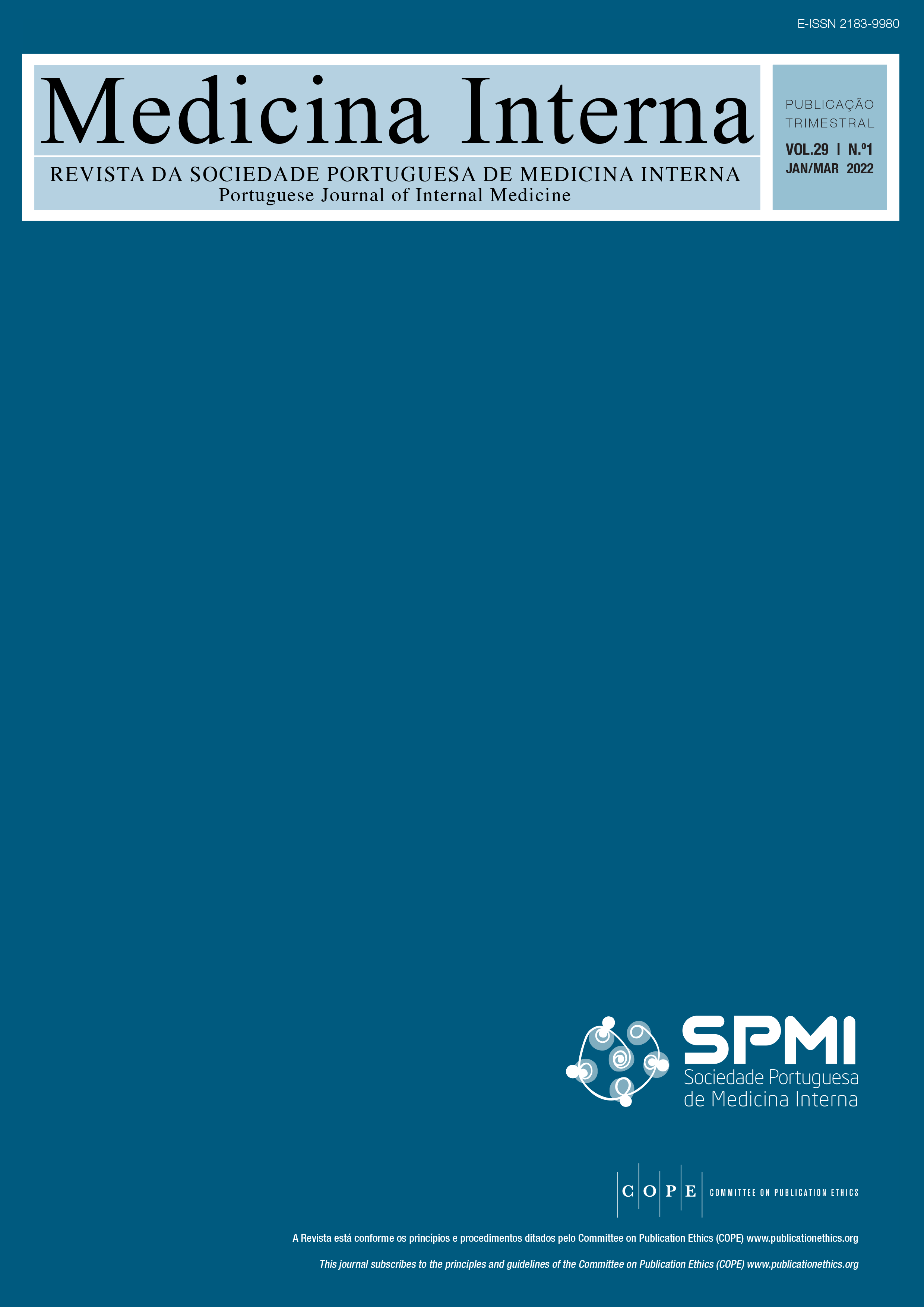Nosocomial Infections. COVID-19: A Friend or Foe?
DOI:
https://doi.org/10.24950/rspmi.2022.01.292Keywords:
COVID-19, Cross Infection/prevention & control, Infection ControlAbstract
Introduction: Nosocomial Infections constitute a public health problem and bring excess avoidable costs associated with hospital admissions. Over the COVID-19 pandemics there was a shift in policies focusing on infection prevention and control programs.
Methods: We postulate that such shift may have an indirect effect in the occurrence of nosocomial infections. We performed a retrospective study aiming to compare the differences in nosocomial infection prevalence between a COVID19 period and a non-COVID-19 period, in a free-COVID-19 Internal Medicine ward from a central hospital in Lisbon. We included 393 patients, 192 patients being from the non-COVID-19 period and 201 patients from the COVID-19 period.
Results: We found a statistically significant reduction in the occurrence of nosocomial infections in the COVID-19 period from 16.1% (n = 31) to 5.5% (n = 11) (p = 0.001; OR 0.301; 95% CI: 0.146-0.617). We also found a statistically significant reduction in antibiotic usage (n = 31; 16.1% vs n = 11; 5.5%; p = 0.001) and in the occurrence of multidrug resistant organism infection (n = 9; 29.0% vs n = 1; 9.1%; p = 0.009) in the COVID-19 period.
Conclusion: Our results confirm that after implementation of systematic infection control protocols there was a reduction in nosocomial infections. We suggest further investigation to validate the data obtained and a cost-benefit analysis to clarify whether the universal implementation of infection prevention and control measures will add value to the treatment of patients.
Downloads
References
Horan TC, Andrus M, Dudeck MA. CDC/NHSN surveillance definition of health care–associated infection and criteria for specific types of infections in the acute care setting. Am J Infect Control. 2008;36:309–32.
Cassini A, Plachouras D, Eckmanns T, Abu Sin M, Blank HP, Ducomble T, et al. Burden of Six Healthcare-Associated Infections on European Population Health: Estimating Incidence-Based Disability-Adjusted Life Years through a Population Prevalence-Based Modelling Study. PLoS Med. 2016;13:e1002150. doi: 10.1371/journal.pmed.1002150.
WHO’s first global report on antibiotic resistance reveals serious, worldwi de threat to public health [Internet]. [cited 2020 Oct 10]. Available from: https://www.who.int/mediacentre/news/releases/2014/amr-report/en/
Tchouaket EN, Beogo I, Sia D, Kilpatrick K, Séguin C, Baillot A, et al. Protocol for a systematic review of economic analyses of nosocomial infection prevention and control interventions in OECD hospitals. BMJ Open. 2020;10:e037765. doi: 10.1136/bmjopen-2020-037765.
Zhu N, Zhang D, Wang W, Li X, Yang B, Song J, et al. A Novel Coro navirus from Patients with Pneumonia in China, 2019. N Engl J Med. 2020;382:727–33. doi: 10.1056/NEJMoa2001017.
Ge H, Wang X, Yuan X, Xiao G, Wang C, Deng T, et al. The epidemiology and clinical information about COVID-19. Eur J Clin Microbiol Infect Dis. 2020;39:1011–9. doi: 10.1007/s10096-020-03874-z.
Ahn DG, Shin HJ, Kim MH, Lee S, Kim HS, Myoung J, et al. Current Status of Epidemiology, Diagnosis, Therapeutics, and Vaccines for Novel Coronavirus Disease 2019 (COVID-19). J Microbiol Biotechnol. 2020;30:313–24. doi: 10.4014/jmb.2003.03011.
Gandhi M, Yokoe DS, Havlir DV. Asymptomatic Transmission, the Achilles’ Heel of Current Strategies to Control Covid-19. N Engl J Med. 2020;382:2158–60.
Doshi RK, Patel G, Mackay R, Wallach F. Healthcare-associated Infections: epidemiology, prevention, and therapy. Mt Sinai J Med. 2009;76:84- 94. doi: 10.1002/msj.20070.
S Harbarth, C Ruef, P Francioli, P, Widmer A, Pittet D. Nosocomial infections in Swiss university hospitals: a multi-centre survey and review of the published experience. Swiss-Noso Network. Schweiz Med Wochenschr. 1999;129:1521–8.
Nicastri E, Petrosillo N, Martini L, Larosa M, Gesu GP, Ippolito G; INF-NOS Study Group. Prevalence of nosocomial infections in 15 Italian hospitals: first point prevalance study for the INF-NOS project. Infection. 2003;31 Suppl 2:10-5.
Eriksen HM, Iversen BG, Aavitsland P. Prevalence of nosocomial infections in hospitals in Norway, 2002 and 2003. J Hosp Infect. 2005;60:40–5.
Shuman EK, Chenoweth CE. Urinary Catheter-Associated Infections. Infect Dis Clin N Am. 2018;32:885–97.
Karam G, Chastre J, Wilcox MH, Vincent JL. Antibiotic strategies in the era of multidrug resistance. Crit Care. 2016;20:136. doi: 10.1186/s13054- 016-1320-7
Vestergaard LS, Nielsen J, Richter L, Schmid D, Bustos N, Braeye T, et al; ECDC Public Health Emergency Team for COVID-19, Krause TG, Mølbak K. Excess all-cause mortality during the COVID-19 pandemic in Europe - preliminary pooled estimates from the EuroMOMO network, March to April 2020. Euro Surveill. 2020;25:2001214. doi: 10.2807/1560-7917. ES.2020.25.26.2001214.
Nogueira PJ, De Araújo Nobre M, Nicola PJ, Furtado C, Vaz Carneiro A. Excess Mortality Estimation During the COVID-19 Pandemic: Preliminary Data from Portugal. Acta Med Port. 2020;33:376-83. doi: 10.20344/ amp.13928.
Downloads
Published
How to Cite
Issue
Section
License

This work is licensed under a Creative Commons Attribution 4.0 International License.
Copyright (c) 2023 Medicina Interna






